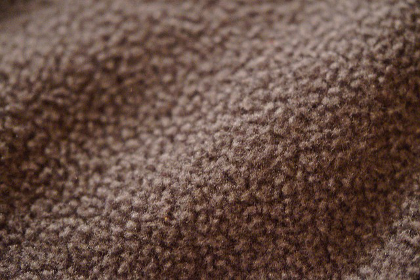
Microfiber Madness: Synthetic Fabrics Harm Wildlife, Poison the Food Supply and Expose You to Toxins
It turns out that clothes made from synthetic fibers shed tiny plastic microfibers in every wash. These microfibers end up in all sorts of waterways—marine, coastal and freshwater—where the tiny fibers are ingested by fish, crabs and other aquatic wildlife. In turn, many of these animals end up in our food supply—and on our dinner plates.
July 20, 2016 | Source: AlterNet | by Reynard Loki
With every wash, your synthetic fleece jacket releases microfibers that harm marine animals.
Doing laundry isn’t something most of us enjoy doing. And now the evidence is clear that the world’s aquatic animals don’t enjoy it either. It turns out that clothes made from synthetic fibers shed tiny plastic microfibers in every wash. This fibrous debris goes from your washing machine, through the municipal sewage system and ends up in all sorts of waterways—marine, coastal and freshwater—where the tiny fibers are ingested by fish, crabs and other aquatic wildlife. In turn, many of these animals end up in our food supply—and on our dinner plates. It seems we are slowly, and literally, eating the shirts off our backs.
A host of recent studies have sounded alarm bells. One frightening conclusion is that these microfibers—a subcategory of microplastics—are even more pervasive in the environment than microbeads, tiny plastic beads common in beauty products that were recently banned in the United States.
One of first researchers to lift the veil on this environmental crisis was ecologist Mark Browne. In 2011, Browne, now a senior research associate at the University of New South Wales in Australia, published a paper in the journal Environmental Science and Technology that concluded microfibers from synthetic fabrics like nylon and acrylic make up 85 percent of human-made debris across the world’s shorelines. The vast majority of that synthetic waste is being released from clothing when it’s washed in laundry machines.
Browne’s experiments were eye-opening. He sampled wastewater from domestic washing machines and found that just one piece of clothing can release nearly 2,000 individual microfibers in a single wash. “As the human population grows and people use more synthetic textiles, contamination of habitats and animals by microplastic is likely to increase,” Browne concluded.
After he published his research, Browne reached out to several leading apparel companies, including Patagonia, Nike and Polartec, in the hopes of forging a collaboration to determine the exact movement of these microfibers—from clothing to oceans—and to develop a more sustainable textile design to stop the crisis from growing. His vision, which he presented in 2013, is called Benign by Design, a program supported by a number of scientists and engineers from academic institutions around the world, including the Environmental Protection Agency. Benign by Design, according to its website, “disrupts the current unsustainable pattern by showing companies exactly how textile wear leads to fiber pollution and ways to control their emissions.”
But the companies Browne approached weren’t interested in supporting his idea. “Perhaps it’s my pitch,” Browne told the Guardian. “We want to look for new, more durable materials that do not emit so much microplastic.” Only one firm, Eileen Fisher, accepted his proposal, giving him $10,000 to support his work.
“Any lifecycle issue, especially when it’s about a huge consumer product like clothing, is important,” Shona Quinn, sustainability leader at Eileen Fisher, told the Guardian. “[Browne] is raising an issue no one else has been studying.” Alas, Eileen Fisher isn’t a main source of the problem: 90 percent of its clothing is made from natural textiles. Still, receiving the funding was validation of Browne’s work.
Then, in an ironic twist, Patagonia itself validated Browne’s work when a study it funded that was conducted by researchers at the Bren School of Environmental Science and Management at UC Santa Barbara was released in June. The researchers analyzed water and sediment samples from around the world and concluded that, indeed, “microfibers are ubiquitous in aquatic environments.” They also analyzed the wash cycles of four different types of synthetic Patagonia jackets (and one budget fleece jacket for comparison).
Here are some of the details of what they found:
• Finished apparel products contain large quantities of chemical substances… many of which are released from garments during consumer washing. This indicates that microfibers are of particular concern regarding their potential to transport hazardous chemicals into the environment.
• Wastewater treatment plants (WWTPs) receive large amounts of microfibers daily.
• While most of these microfibers are removed, a significant amount is still released into the local environment.
• Aquatic organisms throughout the food chain consume microplastics and microfibers both directly and indirectly.
• Within the food chain, these particles have been found to cause physical and chemical impacts, resulting in starvation and reproductive consequences in species.
• Synthetic fleece jackets release an average of 1.7 grams of microfibers with every wash.
• Older synthetic fleece jackets shed nearly two times the amount of microfiber than new ones.
Curiously, the Patagonia study found that top-loading washing machines had more than five times the microfiber shedding than front-loading machine in their trials.
The UCSB researchers also noted that, while the main focus of the microfiber pollution research has been on aquatic ecosystems, terrestrial ecosystems are not immune. “It’s increasingly common to apply sewage sludge to agricultural fields so more fibers are being found on land,” they noted.
